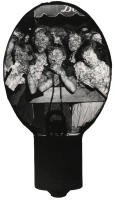
Weegee (1899-1968), [Fireman enjoying a cup of coffee after tenement fire, New York], July 27, 1941 (15131.1993)
Yeah, I reckon I do get the breaks. But I get them because I stay around and work for them. I have no wife – no family. No home. Just a little room across from headquarters. I have no vacations. No recreations. No time out for friends or parties – unless you count a glass of beer now and then or a cup of coffee with some pretty girl I meet on the job. Most of my life is spent in waiting for things to happen. (Rosa Reilly, Popular Photography, December 1937, p. 78)
Every day to work I wore a white shirt, reasonably clean, with a hard Arrow collar and tie, and knickers. My mother gave me a couple of sandwiches and fifteen cents, ten cents for carfare and a nickel for a pint of milk. Many mornings, when there was no money, I had to take my alarm clock to the pawnshop. I hocked it for half a dollar. On pay day, I always redeemed that clock. Big Ben spent more time in the hock shop than with me. I used to envy the other employees when, at lunch time, they would go to the comer saloon and, for the price of a nickel beer, get a hot free lunch… soup, meat sandwiches, etc. Me being in knee pants, I wasn’t allowed into the saloon. A coffee break had not yet been invented. Besides helping the photographer from eight in the morning till six in the evening, I ran his errands, dried prints, swept up, and did whatever else had to be done. (“Weegee by Weegee,” p. 15)

Weegee (1899-1968), [Intermission at Metropolitan Opera, New York], ca. 1944, (7357.1993)
One of the fellows I met suggested that it wasn’t too difficult to get a part-time job in the Automat restaurants, so we went to the one at Broadway and Houston. The manager hired us as extra bus boys for the lunch-hour rush. I was given a white coat and apron and a tray, and told to pick up the dirty dishes. I worked from ten-thirty to two-thirty. Before starting work I had corn muffins and coffee. When we were through we ate everything that was left over. Then we were given a dollar bill and told to come back again the next day. (“Weegee by Weegee,” p.21)

June Duckworth, [Weegee smoking a cigar and sitting at a table with coffee cup and camera], ca. 1960 (21656.1993)
ACME was located in the huge Printing Crafts building, at Eighth Avenue and Thirty-fourth Street, that had twenty-four hour elevator service and heat all night long. The bench in the dark room became my bed. I brought in a mattress, pillow and blankets, and stored them in my locker. I rather enjoyed the camping out, especially with no rent – always the bane of my existence- to pay. I stocked up om George Washington powdered coffee, Campbell’s soups, Heinz’s baked beans (vegetarian style – no pork), and Uneeda biscuits… (“Weegee by Weegee,” p. 30)
The police reporters, who had their offices in the back of headquarters, were a friendly bunch. I made myself useful by running across the street and bringing the slips back from the teletype machine, getting them coffee. When a story broke, I’d hitch a ride with them. (“Weegee by Weegee,” p. 37)

Unidentified photographer, [Weegee drinking coffee and smoking a cigar], ca. 1960 (21716.1993)
If I wasn’t riding in police equipped short wave cars, I waited in the lobby at Police Headquarters in Center Street. My favorite easy chair was near the elevators. I smoked cigars with cops bringing me fresh containers of coffee. I knew everyone from the Police Commissioner down. Having the run of the whole police headquarters I would retire to sleepy to Missing Persons Bureau offices for a doze leaving word with the cop at the information desk not to be disturbed unless something really hot came over the Police Teletype. (“Murder is My Business,” pp.9-10)

Unidentified photographer, [Weegee drinking coffee and smoking a cigar in a cafe], 1968 (20930.1993)
It is easy enough to create distortion photographically by such means as relatively short lenses or by tilting the enlarger easel. The problem of caricature is to choose the distinctive and/or peculiar features of the subject and to exaggerate them. In photography this is no simple achievement. Perhaps only a Weegee could have brought it off. Sad-eyed, he toils away through the New York night in a locked, secret room like a troll in an old German fable. A coffeemaker maintains him through the long hours – “the time of fantasy” he calls it – while the rest of the city sleeps… To all those who have seen his pictures and who want Weegee to caricature them, this professional eccentric, gadfly, and scandalizer replies: “You are a caricature.” Then he retreats to the locked room, the coffee-pot, the cigars, and the secret formulas. (“Popular Photography,” September 1956, pp. 77-80)

Les Barry, “Popular Photography,” April 1958, p. 126
Monday – Midnight
Hello dear,
Got the 2 cans today from the cigar man – thanks for the shoes, cigars, cigarettes + coffee. Especially the Coffee-Mate, incidentally the Chock Full of Nuts Instant Coffee, which you sent the last time, is the most wonderful stuff. Just like the real coffee… (Letter from Weegee to Wilma Wilcox, September 10, 1963) (2009.70.51)
Am learning to speak French, I can order a coffee with a glass of water… (Letter from Weegee to Wilma Wilcox, ca. 1958) (2009.70.68)


Pingback: Part 2: Project 3 | A night portrait 2.9 (Weegee research) – GPowell OCA Photography